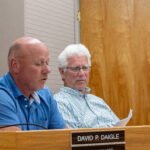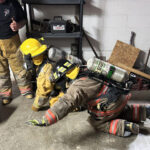HOULTON, Maine — An Orono-based search and rescue group is preparing to look for a Houlton-based pilot who went missing after his plane disappeared on a stormy day more than 43 years ago.
Richard Bowie, director of the Downeast Emergency Medicine Institute, said last Thursday that the nonprofit organization is gathering data to conduct a search for the plane piloted by Lewis “Billy” Hogan Jr.
DEEMI also is partnering on the project with the Old Town Aviation Explorers Post 787, a development program for youths interested in aviation careers.
Hogan was 28 years old and working for LISAir when he left Danbury, Conn., at 8:15 a.m. on May 2, 1972, in a brand-new, yellow-and-white single-engine Citabria. He was expected to land at Houlton International Airport later that day, but communication was lost somewhere between Kennebunk and Augusta. Search crews never found his remains or any trace of the plane.
“The students who are in the Explorers Post have sent Freedom of Information Act requests out to the the Federal Aviation Administration [and other agencies that might have been involved in the search], trying to get all of the information they can about that last flight,” Bowie said. “We want the conversation between the cockpit and the control tower, the search area, any information they can provide to us.”
Bowie said that he learned about the story of Lewis Hogan Jr. through an October 2015 Bangor Daily News article. Hogan’s brother, Jerome Hogan, still lives in Bangor and had contacted the BDN this fall in hopes of stirring up enough interest to have a state or federal agency reopen the case.
Despite the passage of 43 years, Jerome Hogan said he thought today’s technology might be used to locate the remains of the plane. While the FAA and National Transportation Safety Board were not expected to reopen the case without any new information, Hogan said he is excited about DEEMI and the Aviation Explorers Post offering to help find his brother.
On that stormy day in 1972, Billy Hogan was using a type of short-range radio navigation system known as VOR to determine his position and keep the aircraft on course. The system works by receiving radio signals transmitted by a network of fixed ground radio beacons, but on that day the beacon at the Augusta airport was out of service for about four hours, according to the Maine Civil Air Patrol.
According to news accounts at the time, authorities believe Hogan apparently got lost after he unsuccessfully tried to switch from the Kennebunk VOR beacon to the Augusta beacon as he was flying north.
Bowie said on Thursday that DEEMI and the Explorers will use modern technology to analyze the data they gather to re-enact the weather conditions on the day of Hogan’s last flight and to simulate his cockpit conditions.
“I think that it is likely that Mr. Hogan either went down in a thick canopy of woods or he went down in the bottom of a lake,” he said. “I think it is highly unlikely that he went out to sea.”
Bowie praised those who had previously conducted searches for Hogan, and said that their documents “can only help in the future.”
“Who knows what these documents will tell us if you have fresh eyes looking at them,” he said. “There may be things in them that we did not know before.”
All searches conducted by DEEMI are done on a volunteer basis.
“This will be a good training opportunity for us,” he said. “And it will be a good opportunity to bring the family closure if we can find Mr. Hogan’s plane.”







